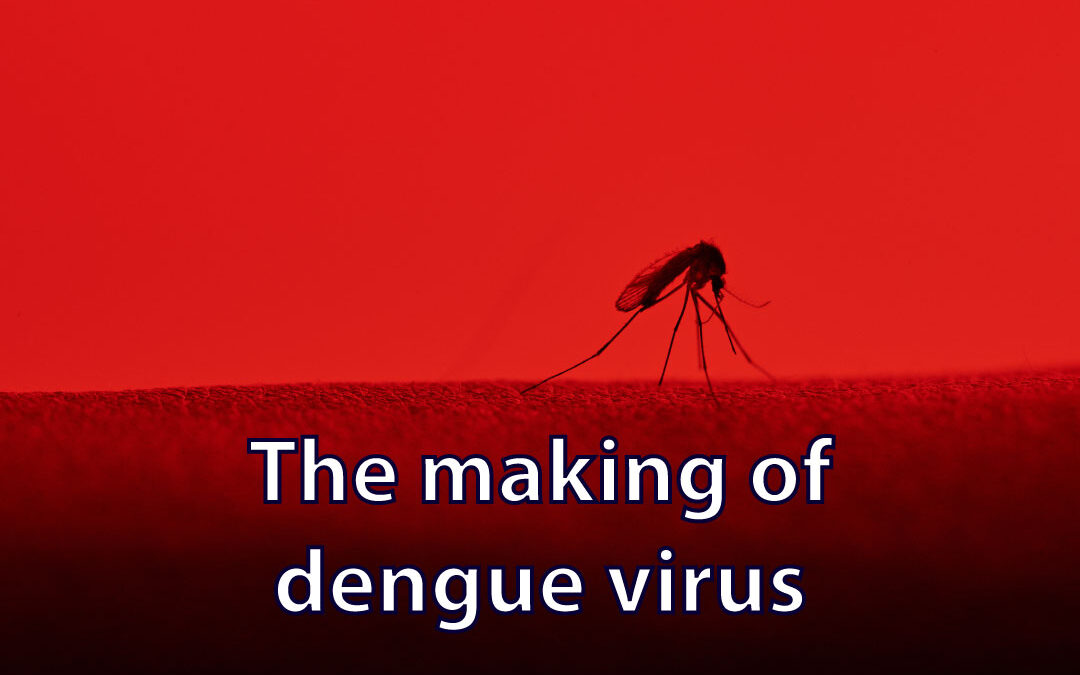The RNA genome of dengue virus (DENV) encodes seven nonstructural proteins that are essential for viral replication (NS1, NS2A, NS2B, NS3, NS4A, NS4B, and NS5). In this month’s post, we dissect the characteristics and roles of NS1, a multifunctional glycoprotein that offers a potential target for both therapeutics and vaccine design.
DENV NS1 is a 352-amino acid polypeptide with a molecular weight of 46–55 kDa, depending on its variable glycosylation status. Highly conserved among all flaviviruses, NS1 is essential for viral replication, virion production, immune evasion, and pathogenesis. Initially, NS1 is expressed as a water-soluble monomer in infected cells. Following glycosylation in the trans-Golgi network, the NS1 monomer forms homodimers that associate with intracellular membranes and the plasma membrane. NS1 is also continuously secreted by infected host cells and released in the bloodstream during acute illness, where its presence is useful as a diagnostic biomarker.
NS1 is secreted in a hexamer form, which is composed of three dimers with a hydrophobic central pocket containing specific lipid cargoes (triglycerides, cholesteryl esters, and phospholipids). NS1 seems to acquire its lipid cargoes during the dimerization process itself, likely during the initial interaction of NS1 dimers with intracellular membranes. This lipid-rich structure can help secreted NS1 attach to the cell membrane by associating with glycosaminoglycans. Given this lipid binding property, it has also been postulated that NS1 contributes to the modulation of cellular lipid dynamics during flavivirus infection. The presence of two N-glycosylation sites at Asn130 and Asn207An is critical for NS1 hexamer stability and secretion.
NS1 plays a role in viral replication
NS1 localizes in the lumen of the ER with double-stranded RNA and other components of the viral replication complex. Through interactions with NS4A and NS4B, NS1 plays a role in viral replication and negative-strand viral RNA synthesis. The two N-glycosylation sites at Asn130 and ASn207 are essential not only for NS1 secretion but also for NS1’s role in viral replication. Removal of either one or both glycosylation sites results in decreased virus yield, as well as reduced invasion of the central nervous system in mice. It has also been proposed that NS1 is required in the later steps of the viral replication cycle because of its interactions with the structural proteins E and pr-M in the ER lumen which are crucial for the generation of infectious DENV viral particles.
NS1 and viral immune evasion
The early literature identified DENV NS1 as a complement-binding protein. The complement is a system of plasma proteins that can be activated directly by pathogens or indirectly by pathogen-bound antibody, leading to inflammation, opsonization, or cell lysis via the formation of the C5b-9 membrane attack complex. DENV evades the complement response using NS1, which has been observed in multiple interactions with complement through the C1s, C4, and C4-binding proteins. By binding to these complement effectors, NS1 inhibits the formation of the classical pathway C3 convertase, thereby protecting DENV from complement-mediated neutralization and preventing the killing of infected cells. As if it was not enough, NS1 has been shown to bind also the complement regulator vitronectin in vitro and in infected patients, as well as the mannose-binding lectin, protecting DENV from the lectin pathway of complement.
– NS1–mediated pathogenesis
Beyond its function in viral replication and immune evasion, a growing body of evidence is demonstrating the multifactorial role of NS1 during dengue disease. A substantial proportion of the antibody response to DENV after an infection is directed against NS1 with anti-NS1 antibodies found in convalescent sera after primary and secondary DENV infection.
– NS1–mediated vascular leak Although NS1 has not been shown to play a direct pathogenic role during DENV infection, recent research advances are showing that DENV NS1 alone can induce endothelial hyperpermeability in multiple human cell lines by inducing the degradation of the endothelial glycocalyx-like layer, which results in barrier dysfunction. In mice, when administered with a sublethal dose of virus, NS1 alone was found to trigger vascular leak in the lung, liver, and small intestine.
– NS1 and cytokine-mediated pathogenesis Multiple studies have demonstrated that NS1 can interact with innate immune cells, leading to the secretion of cytokines and other mediators that contribute to viral pathogenesis. When intravenously administrated in mice, DENV NS1 alone can significantly increase the blood levels of both TNF alpha and IL-6 through activation of Toll-like receptor 4. In addition to inflammatory cytokines, NS1 also stimulates high levels of IL-10, an immunoregulatory cytokine, from monocytes. This effect can be blocked using monoclonal antibodies against NS1.
– NS1 and complement activation The anti-NS1 antibody activates the complement system in an attempt to lyse DENV-infected cells. However, since NS1 is secreted and binds non-specifically to cell membranes, it has been hypothesized that it could trigger complement-mediated lysis of uninfected cells and thus, potentially enhance viral pathogenesis.
The DENV NS1 is an intriguing protein whose critical pathogenic roles in dengue disease have been reported by several groups. However, there is still much to discover about NS1’s functions and the related mechanisms. Therapeutic approaches and vaccine development targeting NS1 might hold much potential in efforts to combat dengue disease.




